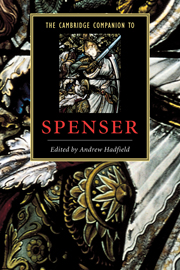Book contents
- Frontmatter
- Introduction
- 1 Spenser's life and career
- 2 Historical contexts: Britain and Europe
- 3 Ireland: policy, poetics and parody
- 4 Spenser's pastorals: The Shepheardes Calender and Colin Clouts Come Home Againe
- 5 The Faerie Queene, Books I-III
- 6 The Faerie Queene, Books IV-VII
- 7 Spenser's shorter poems
- 8 Spenser's languages: writing in the ruins of English
- 9 Sexual politics
- 10 Spenser's religion
- 11 Spenser and classical traditions
- 12 Spenser and contemporary vernacular poetry
- 13 Spenser's influence
- Index
8 - Spenser's languages: writing in the ruins of English
Published online by Cambridge University Press: 28 May 2006
- Frontmatter
- Introduction
- 1 Spenser's life and career
- 2 Historical contexts: Britain and Europe
- 3 Ireland: policy, poetics and parody
- 4 Spenser's pastorals: The Shepheardes Calender and Colin Clouts Come Home Againe
- 5 The Faerie Queene, Books I-III
- 6 The Faerie Queene, Books IV-VII
- 7 Spenser's shorter poems
- 8 Spenser's languages: writing in the ruins of English
- 9 Sexual politics
- 10 Spenser's religion
- 11 Spenser and classical traditions
- 12 Spenser and contemporary vernacular poetry
- 13 Spenser's influence
- Index
Summary
The recent turn towards historicist criticism in Spenser studies, exemplified by the fashion for placing the poet in an Irish context, has inhibited studies of a more formal kind. Critics like S. K. Heninger and Jean Brink have tried to rein in readers bent on contextualising Spenser to death. The last major work on Spenser's language was Herbert Sugden's The Grammar of Spenser's Faerie Queene, first published in 1936 and reissued thirty years later. Sugden's findings - that Spenser's style was cramped by his approach to poetic diction, his desire to enhance poetic language, the limitations of theme and the constraints of his chosen verse form - have found general acceptance. In her contribution to The Spenser Encyclopedia Barbara Strang pointed out the paradox that despite universal acknowledgement of Spenser's facility for language, this aspect of his work 'has received practically no attention during the last thirty years, when items for the Spenser bibliography have been pouring off the presses at an average rate of three a week'. It is a measure of the richness and complexity of the subject that Strang's comprehensive entry on this topic is supplemented by separate essays on dialect, etymology, glossing, morphology and syntax, names, neologisms, pronunciation, puns, rhyme and versification. The problem is that all of these features overlap.
- Type
- Chapter
- Information
- The Cambridge Companion to Spenser , pp. 162 - 179Publisher: Cambridge University PressPrint publication year: 2001
- 3
- Cited by



